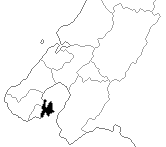Related Research Articles
Arch Hill was one of 80 electorates in New Zealand between 1946 and 1954. Located in central Auckland, the electorate was considered a safe seat for the Labour Party in its eight years of existence.
Karori was a New Zealand electorate, situated in the west of Wellington. It existed from 1946 to 1978, and was represented by three different Members of Parliament during that period, all of them are represented by National Party due to being a wealthy suburb.
Piako was a New Zealand parliamentary electorate established in 1946 and disestablished in 2008. It was last held by Lindsay Tisch MP from 2002 to 2008.

Rotorua is a New Zealand parliamentary electorate, returning one Member of Parliament to the New Zealand House of Representatives. It was first established in 1919, and has existed continuously since 1954. The current MP for Rotorua is Todd McClay of the National Party, who won the electorate in the 2008 general election from incumbent Labour MP Steve Chadwick.
Brooklyn was a New Zealand parliamentary electorate in Wellington city from 1946 to 1954. It was represented by two prominent members of the Labour Party: Peter Fraser, who was Prime Minister (1940–1949), and Arnold Nordmeyer, who was later Minister of Finance (1957–1960).

Island Bay was a former New Zealand electorate, centred on Island Bay in the southern suburbs of Wellington. The electorate was formed in 1946 and dissolved in 1996.

Miramar was a New Zealand parliamentary electorate in the south-eastern suburbs of Wellington. It was created in 1946, replacing Wellington East, and was replaced by Rongotai for the first MMP election of 1996.
Hamilton is a former New Zealand parliamentary electorate that existed from 1922 to 1969. The electorate covered the urban area of the city of Hamilton. In 1969, the city was part of two rural electorates, Hamilton East and Waikato. For the 1972 election, the nature of Hamilton East changed to urban, and the Hamilton West electorate complements it to form a second urban electorate.
Waimarino was a New Zealand parliamentary electorate that existed from 1911 to 1954, and from 1963 to 1972. It was rural in nature and was represented by four Members of Parliament.
Hobson is a former New Zealand parliamentary electorate. It existed from 1946 to 1978 and then from 1987 to 1996, and was represented by five Members of Parliament, four of whom represented the National Party. It is notable for returning a member of the Social Credit Party in the 1966 election, as no other candidate not aligned with either Labour or National had been elected to Parliament since 1943. With the re-drawing of boundaries in the first MMP election in 1996, the seat was absorbed into the Northland and Whangarei electorates.
Fendalton is a former New Zealand parliamentary electorate. It existed during two periods between 1946 and 1996. The electorate was in the western suburbs of Christchurch, New Zealand. Fendalton is an expensive suburb, and was always represented by the National Party.
St Kilda is a former New Zealand parliamentary electorate. It existed from 1946 to 1996 and was represented by four Members of Parliament.
South Canterbury is a former parliamentary electorate, in South Canterbury, New Zealand. It existed for three parliamentary terms from 1969 to 1978.
Stratford is a former parliamentary electorate, in Taranaki, New Zealand. It existed from 1908 to 1946, and from 1954 to 1978. It was represented by six Members of Parliament.

Heretaunga is a former New Zealand parliamentary electorate, in the city of Upper Hutt, that existed from 1954 until 1996.
Mornington is a former parliamentary electorate from 1946 to 1963, centred on the suburb of Mornington in the city of Dunedin, New Zealand.
Parnell was a parliamentary electorate in the city of Auckland, New Zealand, from 1861 to 1954, with one break of eight years.
Temuka was a parliamentary electorate in the Canterbury region of New Zealand from 1911 to 1946. The electorate was represented by four Members of Parliament.
Ponsonby was a parliamentary electorate in Auckland, New Zealand from 1887 to 1890 and from 1946 to 1963. The Ponsonby electorate was represented by two Members of Parliament.
Waimate was a parliamentary electorate in the Canterbury region of New Zealand from 1881 to 1893 and from 1946 to 1957. It was represented by three Members of Parliament.
References
- McRobie, Alan (1989). Electoral Atlas of New Zealand. Wellington: GP Books. ISBN 0-477-01384-8.
- Wilson, James Oakley (1985) [First published in 1913]. New Zealand Parliamentary Record, 1840–1984 (4th ed.). Wellington: V.R. Ward, Govt. Printer. OCLC 154283103.
- Norton, Clifford (1988). New Zealand Parliamentary Election Results 1946–1987: Occasional Publications No 1, Department of Political Science. Wellington: Victoria University of Wellington. ISBN 0-475-11200-8.